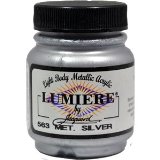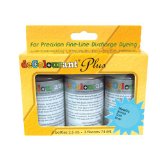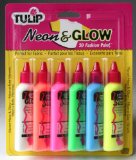I am trying to create a galaxy-like effect on black polyester non-roll elastic. What would I need to do it?
Name: Fabulous
—ADVERTISEMENTS—

Jacquard Products Lumiere Fabric Paint: Metallic Silver


Metallic Decolourant Plus
Contains both a dye remover and a fabric paint, to remove the background and add metallic color at the same time!


Tulip Paint Starter Kits-Neon/Glow
Glow-in-the-dark and blacklight-reactive fabric paints work best when painted over white spots in the fabric.

Country or region: United States
Message: Hi, how are you? I am trying to create a galaxy-like effect on black polyester non-roll elastic. How would I be able to achieve this or would I be able to do the sprinkle effect? If not, could I do it on the same polyester elastic but in white color? What would I need to do it? Thank you in advance for your time.
There are three different ways you could create white dots on a black background.
Probably the best method is to start with black material, and sprinkle on opaque, metallic, or pearlescent fabric paint, or carefully apply them with a fine-pointed brush. Metallic and pearlescent fabric paints would be particularly nice for a galaxy, I think. (Look at good color photos of space images to see the variety of colors in the different stars in a single galaxy!) Be careful to choose a brand of fabric paint which is recommended by the manufacturer for polyester, such as Jacquard Products Lumiere or Neopaque fabric paints. You could dip a toothbrush in the paint, and spatter it onto the fabric using a gloved hand; be careful to test your technique on some scrap material first! After allowing the fabric to dry, you will probably have to heat-set it with a hot iron; check the manufacturers' instructions. Later, when laundering the material, be careful to avoid abrasion in the washing machine; turn garments inside out, and place them inside a mesh lingerie-washing bag, before washing them, because fabric paint tends to wear badly in the washer or dryer.
It is possible to use a dye remover, instead of paint, to create white dots on a black background. Do not ever use chlorine bleach on polyester or other synthetic fabrics, because the bleach will yellow polyester, and will eat away at lycra and other stretch fabrics. You can safely use a sulfur-based dye color remover, such as deColourant spray or cream, or Jacquard Discharge Paste. It's a little more difficult than using fabric paint. A serious drawback with color remover techniques is that it is impossible to predict whether a given black dye will lose color at all; even if it works well one time, the next time you buy an apparently identical piece of elastic, it may have been dyed with a different black dye which does not work at all.
The third possibility is to apply a resist in the shape of the galaxy before using a black dye. For dyeing cotton, you might use spatters of wax, but this won't work for polyester, since all polyester dyes require high heat, which would melt the wax. However, you can apply black disperse dye by first painting it onto paper, then ironing it on to transfer the dye to polyester and other synthetic fibers; if you were to sprinkle little cut-outs of aluminum foil across the fabric before doing the heat transfer with the iron, they would prevent the dye from accessing the fiber, resulting in white spots in the shape of your aluminum foil cutouts. This is a wonderful method for smaller areas on smooth fabric, but is not suitable if you want all of your elastic material to be dyed evenly, since it is impossible to apply transfer dyes perfectly evenly to all of the material.
(Please help support this web site. Thank you.)
There are three different ways you could create white dots on a black background.
Probably the best method is to start with black material, and sprinkle on opaque, metallic, or pearlescent fabric paint, or carefully apply them with a fine-pointed brush. Metallic and pearlescent fabric paints would be particularly nice for a galaxy, I think. (Look at good color photos of space images to see the variety of colors in the different stars in a single galaxy!) Be careful to choose a brand of fabric paint which is recommended by the manufacturer for polyester, such as Jacquard Products Lumiere or Neopaque fabric paints. You could dip a toothbrush in the paint, and spatter it onto the fabric using a gloved hand; be careful to test your technique on some scrap material first! After allowing the fabric to dry, you will probably have to heat-set it with a hot iron; check the manufacturers' instructions. Later, when laundering the material, be careful to avoid abrasion in the washing machine; turn garments inside out, and place them inside a mesh lingerie-washing bag, before washing them, because fabric paint tends to wear badly in the washer or dryer.
It is possible to use a dye remover, instead of paint, to create white dots on a black background. Do not ever use chlorine bleach on polyester or other synthetic fabrics, because the bleach will yellow polyester, and will eat away at lycra and other stretch fabrics. You can safely use a sulfur-based dye color remover, such as deColourant spray or cream, or Jacquard Discharge Paste. It's a little more difficult than using fabric paint. A serious drawback with color remover techniques is that it is impossible to predict whether a given black dye will lose color at all; even if it works well one time, the next time you buy an apparently identical piece of elastic, it may have been dyed with a different black dye which does not work at all.
The third possibility is to apply a resist in the shape of the galaxy before using a black dye. For dyeing cotton, you might use spatters of wax, but this won't work for polyester, since all polyester dyes require high heat, which would melt the wax. However, you can apply black disperse dye by first painting it onto paper, then ironing it on to transfer the dye to polyester and other synthetic fibers; if you were to sprinkle little cut-outs of aluminum foil across the fabric before doing the heat transfer with the iron, they would prevent the dye from accessing the fiber, resulting in white spots in the shape of your aluminum foil cutouts. This is a wonderful method for smaller areas on smooth fabric, but is not suitable if you want all of your elastic material to be dyed evenly, since it is impossible to apply transfer dyes perfectly evenly to all of the material.
(Please help support this web site. Thank you.)
Posted: Thursday - July 04, 2013 at 08:50 AM
Follow this blog on twitter here.
Quick Links
- All About Dyes & Dyeing Top -
- Top of this blog -
- FAQ -
- The Dye Forum -
- How to Tie Dye - How to Batik -
- Books - Toys - Plants -
- Top of this blog -
- FAQ -
- The Dye Forum -
- How to Tie Dye - How to Batik -
- Books - Toys - Plants -
More in this category:
- -
Statistics
Total entries in this blog:
Total entries in this category:
Published On: Jul 04, 2013 09:26 AM
Total entries in this category:
Published On: Jul 04, 2013 09:26 AM